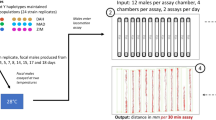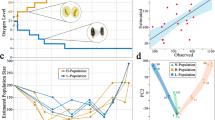Abstract
Restriction fragment length polymorphism (RFLPs) of the mouse period-homologous sequence were studied in 13 populations of the four chromosomal species (2n = 52, 54, 58 and 60) of the mole rat, Spalax ehrenbergi superspecies in Israel. The period locus of Drosophila melanogaster is implicated in controlling the circadian rhythm as well as the male courtship song rhythm. Multiple DNA homologies exist in the mole rat and correspond to more than 10 loci. The level of polymorphism is very high, with a large number of alleles per locus, increasing from the northern to the southern species along a gradient of increasing aridity. Variation was also found in an isolated desert population, with a unique fragment specific to this population. Fragment variation allows distinction between chromosomal species, and confirms earlier evidence that gene flow does not occur between them. A correlation was found between some allelic fragments and the number of apparent harmonics of the courtship calls. This finding suggests an interesting testable hypothesis that the existence of a locus (homology) is responsible for the courtship call parameters.
Similar content being viewed by others
Article PDF
References
Barton, N H, and Charlesworth, B. 1984. Genetic revolutions, founder effects, and speciation. Ann Rev Ecol Syst, 15, 133–164.
Ben-Shlomo, R, Figueroa, F, Klein, J, and Nevo, E. 1988. Mhc class II DNA polymorphisms within and between chromosomal species of the Spalax ehrenbergi superspecies in Israel. Genetics, 119, 141–149.
Bourdon, M A, Oldberg, A, Pierschbacher, M, and Ruoslahti, E. 1985. Molecular cloning and sequence analysis of a chondroitin sulfate proteoglycan cDNA. Proc Natl Acad Sci, USA, 82, 1321–1325.
Carson, H L, and Templeton, A R. 1984. Genetic revolutions in relation to speciation: The founding of new populations. Ann Rev Ecol Syst, 15, 97–131.
Citri, Y, Colot, H V, Jacquier, A C, Yu, Q, Hall, J C, Baltimore, D, and Rosbash, M. 1987. A family of unusually spliced biologically active transcripts encoded by a Drosophila clock gene. Nature, 326, 42–47.
Chopra, R, Pearson, C H, Pringle, G A, Fackre, D S, and Scott, P G. 1985. Dermatan sulphate is located on serine-4 of bovine skin proteodermatan sulphate. Biochem J, 232, 277–279.
Edmunds, L N, JR., 1988. Cellular and Molecular Bases of Biological Clock: Models and Mechanisms for Circadian Timekeeping. Springer-Verlag, New York.
Feinberg, A P, and Voglestein, B. 1984. A technique for radiolabeling DNA restriction endonuclease fragments to high specific activity. Anal Biochem, 137, 266–267.
Feldman, J F. 1982. Genetic approaches to circadian clocks. Ann Rev Plant Physiol, 33, 583–608.
Feldman, J F. 1988. Genetic of circadian clocks. Bot Acta, 101, 128–132.
Georges, M, Cochaux, P, Leouarre, A S, Young, M W, and Vassart, G. 1987. DNA fingerprint in man using a mouse probe related to part of the Drosophila ‘Per’ gene. Nucl Acids Res, 15, 7193.
Georges, M, Lequarre, A S, Castelli, M, Hanset, R, and Vassart, G. 1988. DNA fingerprinting in domestic animals using four different minisatellite probes. Cytogenet Cell Genet, 47, 127–131.
Haim, A, Heth, G, Pratt, H, and Nevo, E. 1983. Photoperiodic effects on thermoregulation in a ‘blind’ subterranean mammal. J Exp Biol, 107, 59–64.
Hall, J C. 1984. Complex brain and behavioral functions disrupted by mutations in Drosophila. Dev Genet, 4, 355–378.
Hall, J C. 1990. Genetics of circadian rhythms. Ann Rev Genet, 24, 659–697.
Holland, I B. 1983. Basic Cloning Techniques: Course manual. University of Leicester, Leicester, U.K.
Jackson, F R, Bargiello, T A, Yun, S H, and Young, M W. 1986. Product of per locus of Drosophila shares homology with proteoglycans. Nature, 320, 185–188.
Jeffreys, A J, Wilson, V, and Thein, S L. 1985. Individual-specific ‘fingerprints’ of human DNA. Nature, 316, 76–79.
Konopka, R J, and Benzer, S. 1971. Clock mutants of Drosophila melanogaster. Proc Natl Acad Sci, USA, 68, 2112–2116.
Kyriacou, C P, and Hall, J C. 1980. Circadian rhythm mutations in Drosophila melanogaster affect short-term fluctuations in the male's courtship song. Proc Natl Acad Sci, USA, 77, 6729–6733.
Li-Weber, M, De Groot, E J, and Schweiger, H G. 1987. Sequence homology to the Drosophila per locus in higher plant nuclear DNA and in Acetabularia chloroplast DNA. Mol Gen Genet, 209, 1–7.
McClung, C R, Fox, B A, and Dunlap, J C. 1989. The Neurospora clock gene frequency shares a sequence element with the Drosophila clock gene period. Nature, 339, 558–562.
Maruyama, T, and Fuerst, P A. 1985. Population bottlenecks and nonequilibrium models in population genetics.II. Number of alleles in a small population that was formed by a recent bottleneck. Genetics, 111, 675–689.
Miller, J, Hatch, J A, Simonis, S, and Cullen, S E. 1988. Identification of the glycosaminoglycan-attachment site of mouse invariant-chain proteoglycan core protein by site directed mutagenesis. Proc Natl Acad Sci, USA, 85, 1359–1363.
Nei, M, Maruyama, T, and Chakraborty, R. 1975. The bottleneck effect and genetic variability in populations. Evolution, 29, 1–10.
Nevo, E. 1978. Genetic variation in natural populations: patterns and theory. Theor Pop Biol, 13, 121–177.
Nevo, E. 1983. Population genetics and ecology: the interface. In: Bendall, D. S. (ed.) Evolution from Molecules to Man, Cambridge University Press, Cambridge, pp. 287–321.
Nevo, E. 1989. Modes of speciation: the nature and role of peripheral isolates in the origin of species. In: Giddings, L. V., Kaneshiro, K. Y. and Anderson, W. W. (eds) Genetics, Speciation and the Founder Principle, Oxford University Press, Oxford, pp. 205–236.
Nevo, E. 1991. Evolution of vocal and vibrational communications in blind, photoperiod-perceptive, subterranean mole rats: Structure and Function. In: Le Berre, M. and Le Guelte, L. (eds) Le Rongeur et L'Espace, Edition R. Cha-baud, Paris, pp. 15–34.
Nevo, E, and Beiles, A. 1988. Genetic parallelism of protein polymorphism in nature: ecological test of the neutral theory of molecular evolution. Biol J Linn Soc, 35, 229–245.
Nevo, E, and Beiles, A. 1989. Genetic diversity in the desert: patterns and testable hypotheses. J Arid Environ, 17, 241–244.
Nevo, E, Beiles, A, and Ben-Shlomo, R. 1984. The evolutionary significance of genetic diversity: ecological, demographic and life history correlates. In: Mani, G. S. (ed.) Lecture Notes in Biomathematics (Evolutionary Dynamics of Genetic Diversity), Springer-Verlag, Berlin, pp. 13–213.
Nevo, E, Ben-Shlomo, R, and Maeda, N. 1989. Haptoglobin DNA polymorphism in subterranean mole rats of the Spalax ehrenbergi superspecies in Israel. Heredity, 62, 85–90.
Nevo, E, Filippuicci, M G, and Beiles, A. 1990. Genetic diversity and its ecology correlates in nature: comparisons between subterranean, fossorial and aboveground, small mammals. In: Nevo, E. and Reig, O. A. (eds) Evolution of Subterranean Mammals at the Organismal and Molecular Levels, Alan R. Liss, New York, pp. 347–366.
Nevo, E, Guttman, R, Haber, M, and Erez, E. 1982. Activity patterns of evolving mole rats. J Mamm, 63, 453–463.
Nevo, E, Heth, G, Beiles, A, and Frankenberg, E. 1987. Geographic dialects in blind mole rats: role of vocal communication in active speciation. Proc Natl Acad Sci, USA, 84, 3312–3315.
Nevo, E, Honeycutt, R L, Yonekawa, H, Nelson, K, and Hanzawa, N. 1993. Mitochondrial DNA polymorphisms in subterranean mole rats of the Spalax ehrenbergi super-species in Israel and its peripheral isolates. Mol Biol Evol. (in press).
Oldberg, A, Antonsson, P, and Heinegard, D. 1987. The partial amino acid sequence of bovine cartilage proteoglycan deduced from a cDNA clone contains numerous Ser-GIy sequences arranged in homologous repeats. Biochem J, 243, 255–259.
Pevet, P, Heth, G, Haim, A, and Nevo, E. 1984. Photoperiod perception in the blind mole rat (Spalax ehrenbergi, Nehr ing): involvement of the Harderian gland, atrophied eyes and melatonin. J Exp Zool, 232, 41–50.
Ralph, M R, and Menaker, M. 1988. A mutation of the circadian system in Golden Hamsters. Science, 241, 1225–1227.
Reddy, P, Jacquier, A C, Abovich, N, Petersen, G, and Rosbach, M. 1986. The period clock locus of D. melanogaster codes for a proteoglycan. Cell, 46, 53–61.
Reppert, S M, Schwartz, W J, and Uhl, G R. 1987. Arginine vasopressin: a novel peptide in cerebrospinal fluid. Trends Neurosci, 10, 76–80.
Robinson, H C, Horner, A A, Ook, M, Ogren, S, and Lindahl, U. 1978. A proteoglycan form of heparin and its degradation to single-chain molecules. J Biol Chem, 253, 6687–6693.
Schwartz, W J, and Zimmerman, P. 1990. Circadian timekeeping in BALB/c and C57BL/6 inbred mouse strains. J Neurosci, 10, 3685–3694.
Siwicki, K K, Strack, S, Rosbash, M, Hall, J C, and Jacklet, J W. 1989. An antibody to the Drosophila period protein recognizes circadian pacemaker neurons in Aplysia and Bulla. Neuron, 3, 51–58.
Shin, H S, Bargiello, T A, Clark, B T, Jackson, F R, and Young, M W. 1985. An unusual coding sequence from a Drosophila clock gene is conserved in vertebrates. Nature, 317, 445–448.
Southern, E M. 1975. Detection of specific sequences among DNA fragments separated by gel electrophoresis. J Mol Biol, 98, 503–517.
Suzuki, H, Moriwaki, K, and Nevo, E. 1987. Ribosomal DNA (rDNA) spacer polymorphism in mole rats. Mol Biol Evol, 4, 602–610.
Takahashi, J S, and Zatz, M. 1982. Regulation of circadian rhythmicity. Science, 217, 1104–1111.
Yu, Q, Colot, H V, Kyriacou, C P, Hall, J C, and Rosbach, M. 1987. Behaviour modification by in vitro mutagenesis of a variable region within the period gene of Drosophila. Nature, 326, 765–769.
Author information
Authors and Affiliations
Rights and permissions
About this article
Cite this article
Ben-Shlomo, R., Shin, HS. & Nevo, E. Period-homologous sequence polymorphisms in subterranean mammals of the Spalax ehrenbergi superspecies in Israel. Heredity 70, 111–121 (1993). https://doi.org/10.1038/hdy.1993.19
Received:
Issue date:
DOI: https://doi.org/10.1038/hdy.1993.19
Keywords
This article is cited by
-
Circadian rhythm and theper ACNGGN repeat in the mole rat,Spalax ehrenbergi
Behavior Genetics (1996)
-
DNA fingerprinting to detect genetic variation in rice using hypervariable DNA sequences
Theoretical and Applied Genetics (1995)
-
Genetic polymorphisms in subterranean mammals (Spalax ehrenbergi superspecies) in the Near East revisited: patterns and theory
Heredity (1994)



